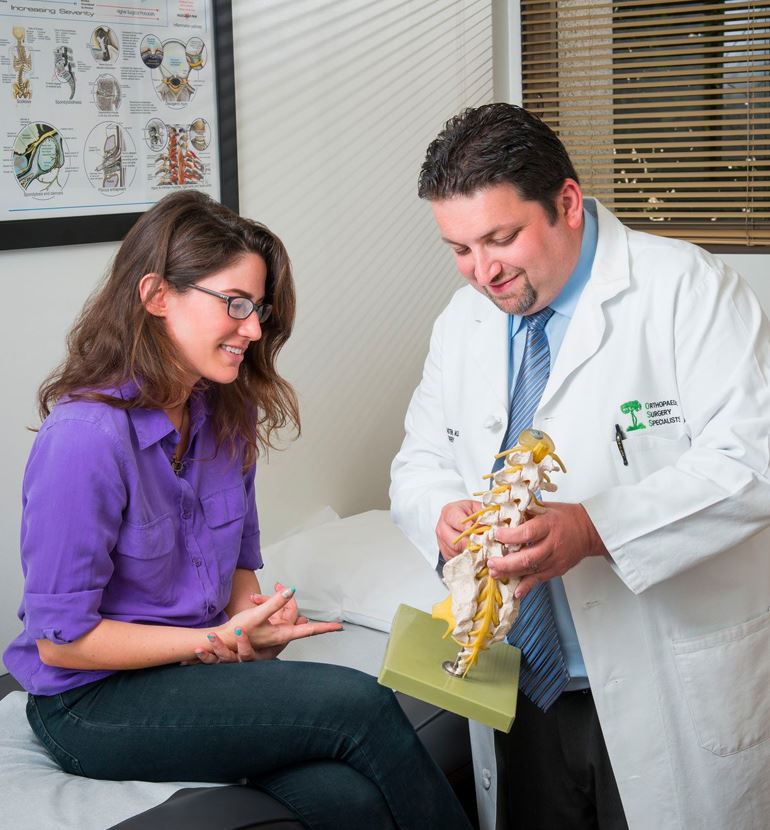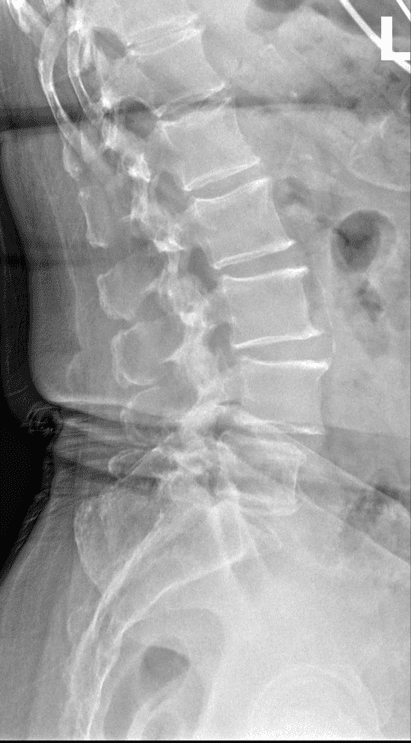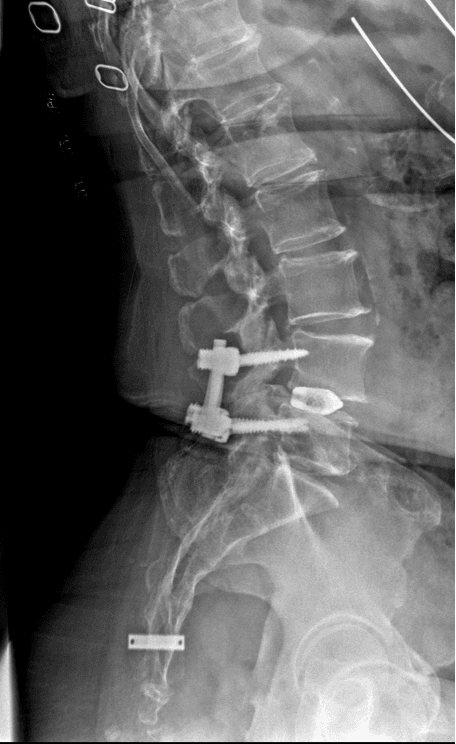

Back
OSS has specialists to help your back
Our team of orthopaedic and pain management specialists utilize the most cutting-edge clinical skills, diagnostic tools, and treatments to take care of the spine and its associated structures.
Meet the the orthopaedic surgeons and pain management specialist who focus on the back:
Non-Surgical Treatments
OSS doctors always start with the most conservative approach (in other words, the least invasive to your body and lifestyle) to help you ease your back pain and improve how you move. Dr. Falkinstein often prescribes most neck and lower back pain with rest, ice or heat, prescription medications, injection therapy (e.g., corticosteroids), and/or physical therapy (OSS offers physical therapy).
Common Surgeries
An interbody fusion can be performed using a variety of different approaches. For example, a surgeon can access the spine through incisions in the lower back or through incisions in the front of the body.
Approaching the spine from the lower back (Posterior Interbody Lumbar Fusion)
In the TLIF approach, an incision is made in the midline of your back to reach the spine. The facet joints, which are directly over your nerve roots may then be undercut (trimmed) to give them more room. A cage made of allograft bone, or posterior lumbar interbody cages with bone graft, is then inserted into your disc space.
Approaching the spine from the abdomen (Anterior Interbody Lumbar Fusion)
ALIF is similar to the posterior lumbar interbody fusion (TLIF), except that in ALIF, the disc space is fused by approaching the spine through your abdomen instead. In the ALIF approach, an incision is made on the abdomen, and the abdominal muscles are retracted to the side. After the blood vessels have been moved aside, your disc is removed, and then, the bone graft or anterior interbody cages is inserted.
Approaching the spine from the flank (Lateral Lumbar Interbody Fusion)
In extreme or direct lateral lumbar interbody fusion (XLIF), the side approach is taken, meaning the incision is made over your flank. With this approach, the surgeon can reach the vertebrae and the disc without moving the nerve branches or opening up muscles in the back. During the procedure, the surgeon removes your disc, and inserts a cage packed with bone graft between the vertebrae.
Percutaneous Vertebroplasty (Kyphoplasty) for Vertebral Fractures
Vertebral body compression fractures of the spine are among the most common fracture types in patients who have weak bones (osteoporosis). They occur when one or more of your bones in the spine weakens and crumples, causing bone destruction. Pain and loss of function are the most common symptoms of fractures. Percutaneous vertebroplasty is a minimally invasive treatment that inserts bone cement into the compressed and fractured vertebrae to provide mechanical stabilization.
Lumbar Microdiscectomy
During a minimally invasive lumbar discectomy, Dr. Falkenstein takes out part of your damaged disc, to help ease the pressure on the spinal cord. One of the methods is to insert a small tube through the skin on your back, between the vertebrae and into the space with the herniated disc. Tiny tools are then inserted through the tube to remove a part of the disc, or a laser may be used to remove part of the disc.
Lumbar Laminectomy/Decompression
Laminectomy is surgery that creates space by removing the bone called lamina (located in the back part of a vertebra) that covers your spinal canal. Also known as decompression surgery, laminectomy enlarges your spinal canal to relieve pressure on the spinal cord or nerves. This pressure is most commonly caused by bony overgrowths within the spinal canal, which can occur in people who have arthritis in their spines.
Lumbar Disc Replacement
Discs between the bones of the spine work like cushions to allow the bones to rotate and move without them rubbing against each other. Lumbar disc replacement involves replacing a worn or degenerated disc in your lower back with an artificial disc that is made of metal or a combination of metal and plastic.
Common Problems
You may have one or more of these problems that is causing pain in your back:
- Back pain (e.g., lower back pain, cervical, thoracic, lumbar strains and/or sprains)
- Weakness felt in the hips or legs (sciatica); pain that radiates into your leg, numbness or tingling (e.g., lumbar disc injury)
- Disc injuries including bulges, degenerations, herniations (formation of excessive bony growth)
- Acute and chronic vertebral fractures
- Spine looks curved (e.g., scoliosis)
Before

After

Complete Approach to Surgery
Minimally invasive techniques for back surgery
Surgery is the last option given to recover from pain. Dr. Falkinstein uses minimally invasive techniques for back surgery. The benefit is that the recovery from back surgery is faster and with less pain.
Here is a preview of what Dr. Falkinstein also does for back surgery and recovery:
- Give you clear instructions on how to plan before and after your surgery so you are more at ease.
- Perform the procedures in well run, accredited surgery centers or in highly ranked hospitals.
- Work with physician anesthesiologists who are highly trained.
- Manage the after-surgery short-term discomfort safely.
- Monitor your recovery in the office and virtually.
- Get you home sooner. In fact, some spine surgeries can be “same day” surgeries, allowing you to return home later in the day. Of course, we offer the option of an overnight stay if you and your doctor determine it’s needed.
- Get you connected to our physical therapy team, so you rebuild your strength and mobility. Our doctors of physical therapy have excellent training and schooling.

Read What Our Patients Say
-
“A talented & sympathetic surgeon, Dr. Falkinstein takes his time with you, explaining your MRI and options in detail. When I opted to go straight to surgery because of my pain level and severity of disc displacement, he got me in within a week! ”- Nicole B.
-
“Dr. Feldman is my go-to ortho….He has been my orthopedic for >12 years… He has performed (my) hip replacement. Spinal fusion. Meniscus tear and cartilage damage repair. He has also done a knee replacement on my left knee…. They focus on getting patients thru and on time; learn their names and you will learn how special they all are. As for Dr. Feldman... ... ”- TRM
-
“Dr. Feldman is the best doctor I ever got. Thank you for being the dedicated, thoughtful, and compassionate doctor that you are! You always go above and beyond and work tirelessly towards a healthy outcome. ”- Kharmen R.
Trusted Medical Sources
To find out more about back injuries, please visit these pages of the American Academy of Orthopaedic Surgeons website:
- Adult Spondylolisthesis in the Low Back
- Anatomy of the Spine
- Back Pain in Children
- Cauda Equina Syndrome
- Cervical Radiculopathy (Pinched Nerve)
- Cervical Spondylotic Myelopathy (Spinal Cord Compression)
- Chordoma (tumor)
- Congenital Scoliosis
- Fracture of the Thoracic and Lumbar Spine
- Herniated Disc
- Herniated Disc in the Lower Back
- Idiopathic Scoliosis in Children and Adolescents
- Kyphosis (Roundback) of the Spine
- Low Back Pain
- Lumbar Spinal Stenosis (narrowing)
- Osteoporosis and Spinal Fractures
- Sciatica
- Scoliosis: Frequently Asked Questions
- Spine Basics
- Spinal Deformity in Children with Myelomeningocele
- Spondylolysis (degenerative arthritis) and Spondylolisthesis (bone slip)
Description of the back
The spine is composed of 33 bones (24 of which can move) and is attached to both pelvic bones at the sacrum. Each of the 24 individually stacked bones is separated by an intervertebral disc that acts as a support to movement and a shock absorber to compressive movements or activities. The spine’s main job is to protect the spinal cord, the main line of communication between the brain and the entire body. Muscles and ligaments help dynamically and statically balance the spine to help sustain postures and act as an anchor to allow for movement of the arms and legs.

